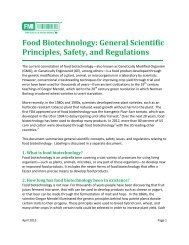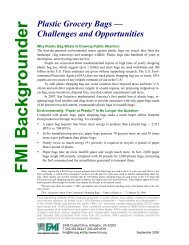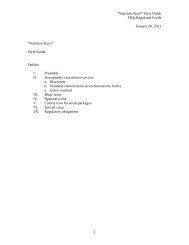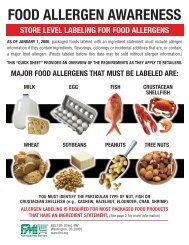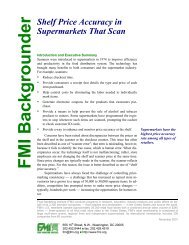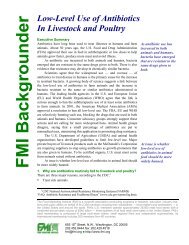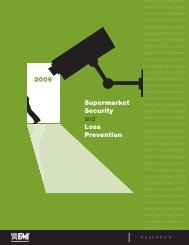Consumer Shopping Habits for Wellness and Environmentally ...
Consumer Shopping Habits for Wellness and Environmentally ...
Consumer Shopping Habits for Wellness and Environmentally ...
Create successful ePaper yourself
Turn your PDF publications into a flip-book with our unique Google optimized e-Paper software.
Services Should be Physically Separate<br />
Regardless of store context, consumers generally feel that any quasi-clinical services should be<br />
per<strong>for</strong>med in a closed off, spatially distinct area, apart from other parts of the store. In many<br />
instances this is driven by privacy concerns, however, in stores where food is a focus, this is also<br />
motivated by a strong urge to keep food <strong>and</strong> anything that may involve bodily fluids <strong>and</strong>/or sick<br />
people separate from the rest of the store.<br />
Expertise Drawn from Outside the Store<br />
<strong>Consumer</strong>s look to authorities outside of the retailer to confirm that personnel per<strong>for</strong>ming health<br />
services have received the proper training. In other words, a ―regular store employee‖ should not be<br />
administering such service; consumers don‘t trust ―someone who might as well be slicing turkey‖ to<br />
provide such services. Instead, they expect a ―real nurse‖ or equivalent, just like, <strong>for</strong> years, they have<br />
trusted that pharmacists have been through a specific educational <strong>and</strong> certification process prior to<br />
working as pharmacists.<br />
Who Pays What?<br />
The tangled web of health insurance is a top-of-mind concern <strong>for</strong> consumers when they consider the<br />
idea of in-store services. <strong>Consumer</strong>s want to know who will pay <strong>for</strong> what, <strong>and</strong> seek to avoid many of<br />
the complications of insurance that they have experienced in the past. This strongly suggests that<br />
any retailer offering such services make insurance/payment details immediately available <strong>and</strong> as<br />
uncomplicated as possible. Of course, those lacking health insurance have no such concerns, <strong>and</strong><br />
would look toward in-store health services as perhaps a less-expensive way to get basic care.<br />
Quantitative Findings on Desirability of Health Services<br />
Learning Features<br />
By learning features, we mean in-store features that in<strong>for</strong>m consumers about H+W in almost any<br />
<strong>for</strong>m, however, in large part we mean advice from store employees <strong>and</strong> signage <strong>and</strong> other fixed<br />
materials that serve as in<strong>for</strong>mation resources.<br />
As we‘ve mentioned in several places in this report, the thirst <strong>for</strong> knowledge that consumers tend to<br />
exhibit in the Mid-level is very important to keep in mind when constructing H+W strategies. This is<br />
particularly important in retail spaces, which <strong>for</strong> many consumers, serves as the primary source of<br />
H+W in<strong>for</strong>mation.<br />
There are some unique challenges <strong>for</strong> some retailers here. In an ideal world, a retailer would be able<br />
to devote significant resources to providing in<strong>for</strong>mational features, especially dynamic elements such<br />
as staffed displays. But, of course, the reality is that resources (<strong>and</strong> space) are limited, <strong>and</strong> often<br />
fixed displays are the only option.<br />
Focus <strong>for</strong> Learning Features<br />
Learning features should focus on explaining, in compact language, what distinguishes products <strong>and</strong><br />
what particular attributes make products desirable. For instance, if building a display to explain the<br />
advantages of an entry-level natural cleaning product, which typically begins to have appeal to<br />
consumers in the ―shallow‖ Mid-level (i.e. just into the Mid-level near the Periphery) there are three<br />
155




